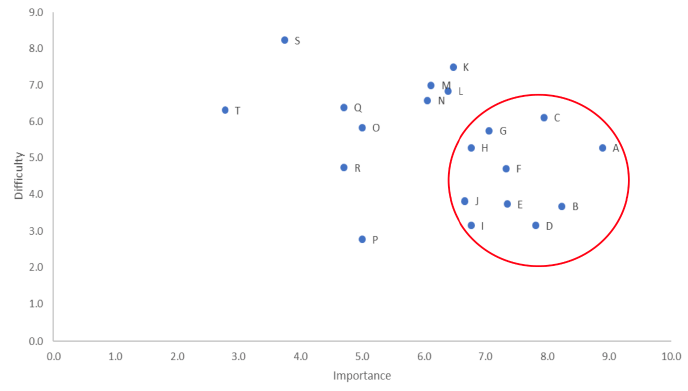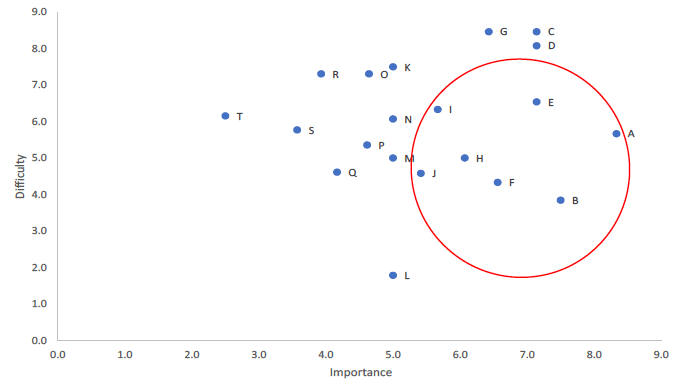Review of the environmental and socio-economic barriers and benefits to organic agriculture in Scotland
Report of the research carried out by Harper Adams University, on behalf of the Scottish Government, into the environmental and socio-economic barriers and benefits to organic agriculture in Scotland.
4. Stakeholder consultation - Table of Priorities
To help identify areas for future prioritisation for the organic sector in Scotland, benefits and barriers, identified in the SWOT analysis, were prioritised in order of importance by members of the Scottish Organic Forum together with some of their members and contacts.
4.1 Methods for gathering stakeholder opinion on priority areas for action
Key benefits and barriers to Scottish farming, as identified in the SWOT analysis, were summarised into two lists. The two lists highlighted key environmental and socio-economic benefits and barriers to organic farming in Scotland. Each list was circulated to members of the Scottish Organic Forum. Members were invited to rate the benefits and barriers for organic farming on importance (High, Medium or Low), difficulty of addressing (Hard, Moderate or Easy) and identify which major groups could be best targeted to address them (Farmer, Consumer or Other). A mean from the ratings of importance from the 19 respondents was calculated to assess the groups’ collective opinion. The items on each list were ranked in order of importance according to the respondents (Tables 5 and 6), and the order of importance was correlated cross-tabulated against the ease of actions to address the barrier or highlight the benefit (Figures 4 and 5).
4.2. Results of the stakeholder consultation
4.2.1. Benefits
Table 5 shows the potential benefits of organic farming in Scotland in order of importance according to the stakeholder group. The group thought that the benefit rated most important to organic farming in Scotland by respondents was (A) Increased demand for organic produce (Table 5). Figure 4 compares the most importance of each benefit with the ease of addressing. Generally the benefits considered most important were also thought to be the ones which could most easily be targeted in with future action. The benefit rated most difficult to address in any future prioritisation was (S) Improved diversity of varieties and livestock genetics to benefit organic producers.
The benefits highlighted as potential targets for future policy due to their high importance in relation to perceived ease of addressing were: (A) Increased demand for organic produce, (B) Organic farming supports greater biodiversity than conventional farming, (D) Organic farming generally supports improvement of soil health characteristics, and (E) Organic subsidies add value to the land by supporting greater biodiversity and ecosystem service provision.
Respondents most commonly highlighted farmers as the major target group for addressing the benefits stated within the table of priorities (Table 5).
Table 5: List of environmental and socio-economic benefits to organic farming in Scotland in order of mean importance – A (most important) - T (least important) – and the main group(s) to target to address each one, according to respondents.
| Benefit | Target group | |
|---|---|---|
| A | Increased demand for organic produce | Consumer |
| B | Organic farming supports greater biodiversity than conventional farming | Farmer |
| C | Organic consumers are motivated to purchase by taste and health, environmental, animal welfare and social concerns | Consumer |
| D | Organic farming generally supports improvement of soil health characteristics | Farmer |
| E | Organic subsidies add value to the land by supporting greater biodiversity and ecosystem service provision | Farmer/ Other |
| F | Management of soil organic carbon to offset climate change potential on organic farms | Farmer |
| G | Potential for realisation of more committed organic consumers through the existing large occasional organic consumer base | Consumer |
| H | Potential for increased competitive ability of organic farms with introduction of carbon and/or pesticide taxes | Farmer/ Other |
| I | Organic farmers more often perceive their land as part of the natural environment | Farmer |
| J | Greater non-marketable ecosystem services provided by organic farming than conventional farming | Farmer |
| K | Consumers willing to pay a premium for organically labelled produce | Consumer |
| L | Rise in number of Scottish certified organic processors | Farmer |
| M | Improved organic infrastructure could increase conversion appeal | Farmer |
| N | Opportunities for higher margins comparative to conventional farming | Farmer |
| O | Organic farms require greater labour which could generate more local jobs | Farmer |
| P | Greater access to training and advice on organic management could increase uptake | Other |
| Q | Improved financial stability with increasing size of organic farm | Farmer |
| R | Improved efficiency of organic subsidies by designating proportionally greater subsidies in regions with low habitat and landscape complexity. This recognises the improved environmental benefit of organic management in such regions | Other |
| S | Improved diversity of varieties and livestock genetics would benefit organic producers | Farmer/ Other |
| T | Young organic farmers are more likely to diversify on-farm activities | Farmer |
Figure 4: The correlation between mean importance of environmental and socio-economic benefits to organic farming in Scotland and the difficulty of addressing them (see Table 6 for key). Letters within the red circle represent priorities that could be considered targets for future policy due to their high importance and perceived ease of implementation.
N.B. Metric calculation: For importance, a rating of High (H) scored 10, Medium (M) 5 and Low (L) 0. For difficulty, a rating of Hard (H) scored 10, Moderate (M) 5 and Easy (E) 0. The scores were totalled for each benefit/barrier and divided by the total number of responses, resulting in a mean score between 0 (lowest importance/easiest to address) and 10 (highest importance/hardest to address).

4.2.2. Barriers
The barrier rated by respondents as the most important to organic farming in Scotland was (A) Poor awareness of the complete benefits of organic farming (Table 6). The barriers rated equally as the most difficult to address were: (C) Reduced certified organic livestock and crop and (G) Reduced organic and in-conversion Scottish land area and producers (Figure 5)
The barriers highlighted as potential targets for future policy, due to both high importance and perceived ease of addressing were: (A) Poor awareness of the complete benefits of organic farming, (B) Direct payments important to financial viability of organic farms, (E) Inconsistent availability of organic produce in markets and supermarkets, and (F) Consumer knowledge of organic certification is low and is often not distinguished from alternative environmental certification i.e. LEAF.
Respondents most commonly highlighted farmers as the major target group for addressing the proposed barriers (Table 6). However, consumers were thought by the stakeholder group to be the priority target for addressing their most important barrier to organic farming (poor awareness of the complete benefits of organic farming).
Table 6: List of environmental and socio-economic barriers to organic farming in Scotland in order of mean importance – A (most important) - T (least important) – and the main group(s) to target to address each one, according to respondents.
| Barrier | Target group | |
|---|---|---|
| A | Poor awareness of the complete benefits of organic farming | Consumer |
| B | Direct payments important to financial viability of organic farms | Farmer/ Consumer |
| C | Reduced certified organic livestock and crop producers (since 2011) | Farmer |
| D | Organic premium doesn't consistently compensate farmers | Farmer |
| E | Inconsistent availability of organic produce in markets and supermarkets | Consumer |
| F | Consumer knowledge of organic certification is low and is often not distinguished from alternative environmental certification i.e. LEAF | Consumer |
| G | Reduced organic and in-conversion Scottish land area (since 2011) | Farmer |
| H | Excessive organic pricing limits purchases | Consumer |
| I | Low availability of labour and affordable rural housing to accommodate workers | Farmer |
| J | AES measures do not account for variable environmental performance of organic management in landscapes of different complexity | Other |
| K | Limited financial stability for smaller organic farms | Farmer |
| L | Some farms keen to gain organic certification are restricted by a lack of technical understanding of organic management | Farmer |
| M | Financial and administrative barriers to organic certification - particularly on small farms | Farmer/ Other |
| N | Trust in production standards and inspection schemes related to the mandatory EU organic certification label is low | Consumer/ Other |
| O | Yield gap between non-organic and organic production | Farmer |
| P | Expectations gap between what consumers expect of organic production and the reality of organic certification | Consumer |
| Q | Evidence of long-term soil phosphorus depletion on organic farms compared to non-organic | Farmer |
| R | Organic farms experience increased financial risk and uncertainty | Farmer |
| S | Inconsistent supply and lack of availability of reliable and cost-effective organic inputs for pests, weed and diseases control | Farmer |
| T | Land tenure limits organic production | Farmer |
Figure 5: The correlation between mean importance of environmental and socio-economic barriers to organic farming in Scotland and the difficulty of addressing them (see Table 7 for key). Letters within the red circle represent priorities that could be considered targets for future policy due to their high importance and perceived ease of implementation. N.B. Metric calculation: For importance, a rating of High (H) scored 10, Medium (M) 5 and Low (L) 0. For difficulty, a rating of Hard (H) scored 10, Moderate (M) 5 and Easy (E) 0. The scores were totalled for each benefit/barrier and divided by the total number of responses, resulting in a mean score between 0 (lowest importance/easiest to address) and 10 (highest importance/hardest to address).

Contact
Email: pamela.blyth@gov.scot
There is a problem
Thanks for your feedback